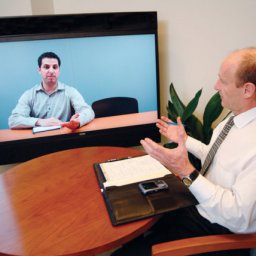Original Post by Dennis Collins
Collaborative leadership helps encourage teamwork and productivity. To be a collaborative leader, you need to be a collaborative communicator. Here’s how you can enhance your collaborative communication skills.
In the column, I shared four behaviors that we, as developers and providers of Unified Communications (UC) solutions, believe are especially important for leading virtual collaboration:
- Be supportive
- Operate with strong results orientation
- Seek different perspectives
- Solve problems effectively
The bullets came from a list of 20 core leadership behaviors offered by McKinsey & Company. The global consulting firm contends that those four qualities in particular “account for 89 percent of leadership effectiveness” in a business. We agreed with McKinsey’s assertion and, in turn, argued those same traits are critical for collaborative leaders.
But still the discussion seemed incomplete. I like to see lists follow the “rule of primes” – i.e., present items in sets of 3s, 5s or 7s. So, I went back to McKinsey’s group of 20 to bring our list of characteristics to a full batch of five. There, I found another worthy element of collaborative leadership:
“Communicate prolifically and enthusiastically.”
Good collaborative leaders should be adept collaborative communicators, because virtual settings place extraordinary demands on communication skills. When some or all members of a team aren’t working in the same room, same building or even same time zone, the lack of proximity creates a gap that text-based communication can’t fill effectively. Important nuances can be missed.
“If you word-spot James Joyce, you’ll miss the entire experience,” Tufts University cognitive neuroscientist Maryanne Wolf once told Fast Company. And in business that “experience” is people coming to know and understand each other—whether the interaction is worker-to-supervisor, leader-to-teammate, peer-to-peer or all three rolled into one session.
A lack of visual cues, such as body language, also can complicate communication in virtual sessions, making the need for special skills even greater.
“Communication is the real work of leadership; you simply can’t become a great leader until you are a great communicator,”emotional intelligence guru Travis Bradberry writes in a recent column for Forbes.
So, we put our own spin on Bradberry’s “secrets of great communicators” to create these five tips for collaborative communicators:
1. Talk Individuals, not Groups
Bradberry believes that when talking to groups “you need to develop a level of intimacy in your approach that makes each individual in the room feel as if you’re speaking directly to him or her.” When the “room” is a virtual setting, this effect can be literal. Audio and video conferences coupled with screen-sharing tools can simulate a one-on-one connection, which leaders should use to convey the energy, enthusiasm and empathy of in-person interactions.
2. Establish a 2-Way Connection
The greatest advantage of virtual collaboration is the ability to share words, pictures and other forms of information at any time, with anyone, in any place around the globe. So, don’t treat this powerful channel like a bulletin board or radio broadcast. “When you communicate,” Bradberry counsels, “you must give people ample opportunity to speak their minds. If you find that you’re often having the last word in conversations, then this is likely something you need to work on.”
3. Share Your Emotions with Your Words
To connect emotionally with team members, Bradberry says, “Be human. Show them what drives you, what you care about, what makes you get out of bed in the morning.” So, don’t become obsessed with technical speaking prowess. For example, some pundits believe utterly eliminating words such as “like, you know, I mean, uh and um” is unnecessary. Instead, learn to use these natural filler words to your advantage.
4. Skip the Jargon
Corporate buzzwords may be contagious, but it isn’t natural. And using it may lower your credibility. So, don’t pepper your communication with “business speak.” Bradberry feels the effect is insincere.
5. Hone Your Listening Skills
Ample research indicates most of us don’t listen as well as we believe we do. For example, researchers at Wright State University surveyed more than 8,000 people from various vertical industries; nearly all respondents rated their own listening abilities as good as or better than their co-workers. Yet, if our research into “things people do while on a conference call” is any indication, these statistics are more aspirational than actual. Listening is critical for any leader in any setting – virtual or in-person. And like any skill, it takes deliberate work. In “3 Ways to Improve Listening Skills During Meetings” we get you started.
Like what you read? We have more! Click here to read more of our blog!



